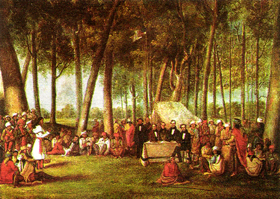
On Sept. 4, 1838, 859 Potawatomi Indians, including 150 from Michigan, were forced to march west on what was called the “trail of death.” Congress passed the Indian Removal Act of 1830 to take fertile land around the Great Lakes from its original American Indian inhabitants. It was not until Gov. William Woodbridge, Michigan’s second governor, that federal and state governments allowed remaining Indians to stay.
The Pokagon Band of Potawatami in Michigan, now headquartered in Dowagiac, Michigan, with a satellite office in South Bend, Indiana, escaped forceful removal from their homelands in 1833 through skillful negotiations by their tribal leader Leopold Pokagon. They are one of eight Potawatomi (meaning “Keepers of the Fire”) Bands extending from Oklahoma to Canada currently recognized by the federal government.
Note : Painting by George Winters depicts council meeting between Potawatomi leaders and U.S. government representatives in July 21, 1837 at Kee-Waw-Nay Potawatomi Village to settle details for the impending removal of the Potawatomi from northern Indiana.
Sources:
Michigan Every Day
“Native History: Potawatomi Removed at Gunpoint, Trail of Death Begins”, Indian Country Today, September 4, 2014.
Andrea Neal, “Indiana at 200 (32): Potawatomi Forced From Indiana”, Indiana Policy Review, August 25, 2014.
Native American Legends : Potawatami Trail of Death
Peggy King Anderson, The Long March, Highlights for Children, October 2002.